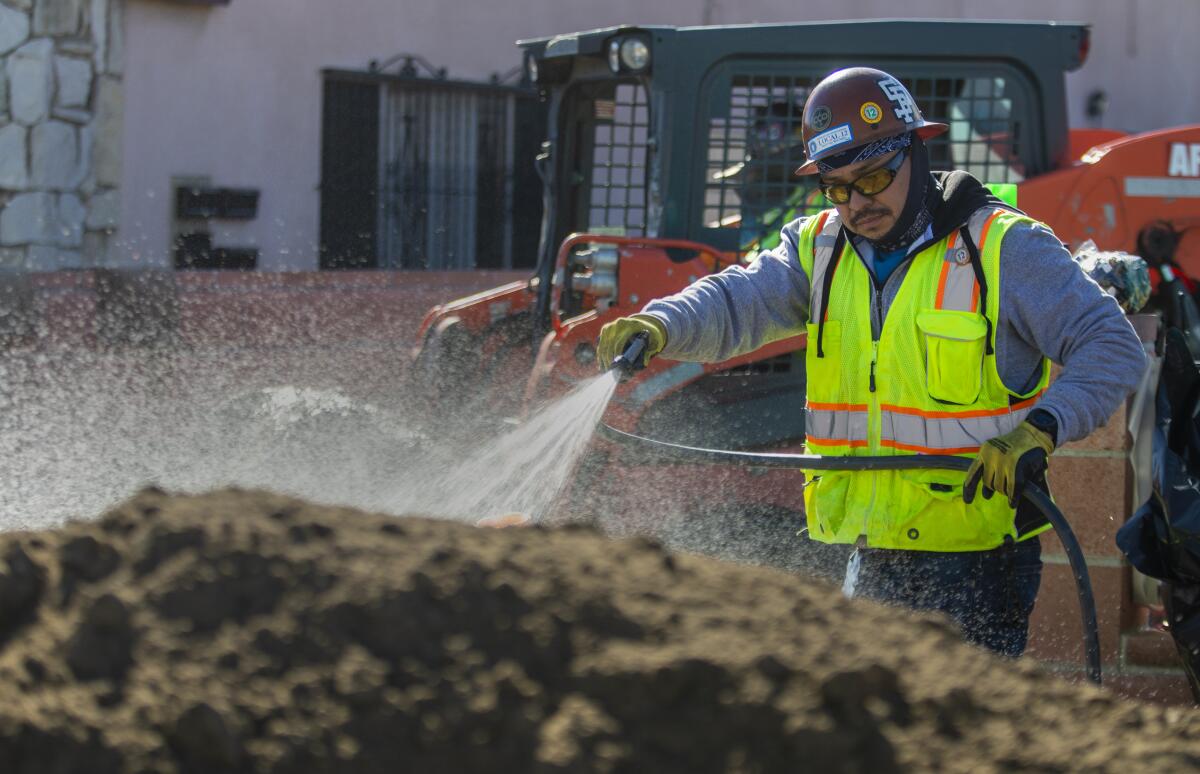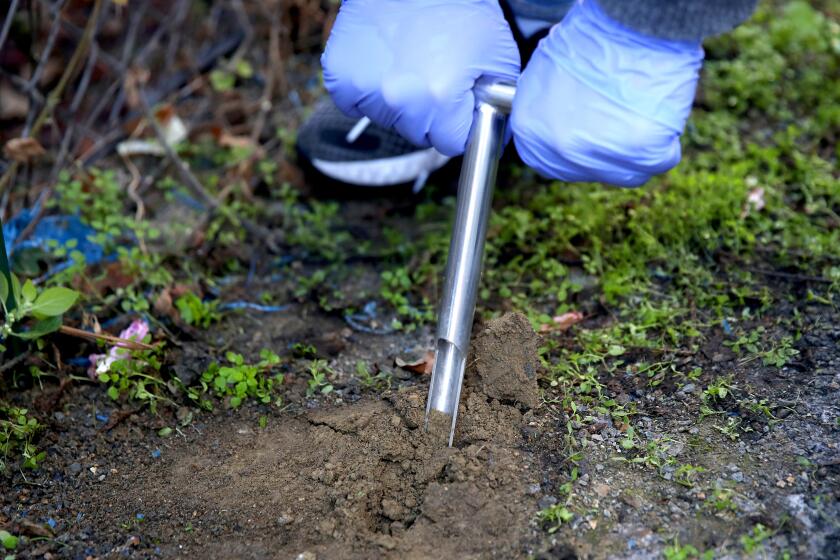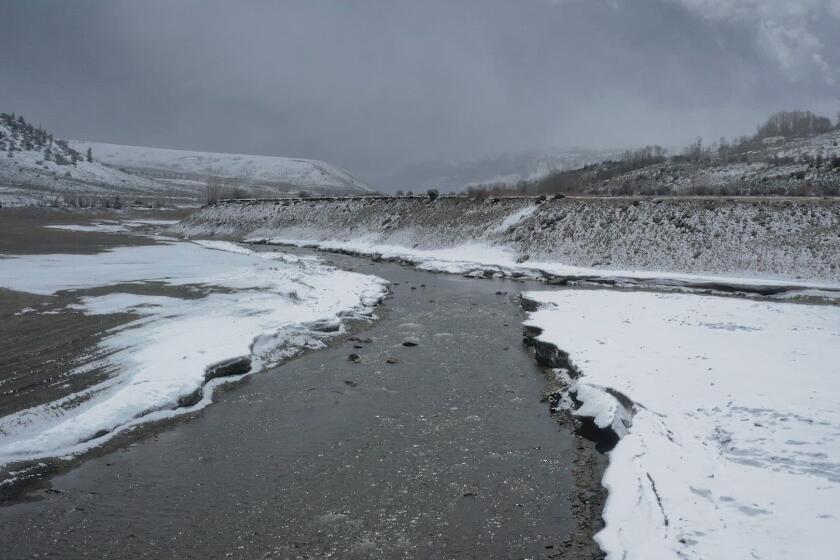Lawmakers demand EPA action on troubled cleanup of lead-contaminated L.A.-area homes

- Share via
Amid California’s long struggle to hold an industrial polluter accountable and remove lead contamination from neighborhoods southeast of downtown Los Angeles, members of Congress are now calling on the federal Environmental Protection Agency to assist in the troubled cleanup of areas surrounding the closed Exide battery recycling plant — the largest and most costly effort in California history.
“It is clear that only the federal government has the capacity to resolve this crisis,” wrote Rep. Robert Garcia of Long Beach and California Sens. Dianne Feinstein and Alex Padilla in a letter Thursday to EPA Administrator Michael S. Regan. The letter cited a Los Angeles Times investigation published last week that found that numerous properties remediated at great cost to state taxpayers have been left with concentrations of lead in their yards in excess of state health standards.
“We believe the severity of the crisis, the failure of past remediation efforts to create healthy communities, and the risk to public health requires assistance from the EPA and the resources available under the Superfund program,” the lawmakers wrote.
Officials with the state Department of Toxic Substances Control, which is overseeing the $750-million remediation effort, did not respond to a request for comment but have supported the idea of federal assistance in the past. They had hoped Exide would be responsible for the cleanup, but the company was allowed to walk away from much of the financial obligation after filing for bankruptcy.
Numerous homes that underwent remediation have been left with lead concentrations in excess of state health standards, according to USC researchers.
Gov. Gavin Newsom welcomed the EPA’s help, a spokesperson said Thursday night.
“Since the bankruptcy courts let Exide off the hook, the Newsom administration has worked closely with the Legislature to fund and implement this massive cleanup,” said Anthony York. “We appreciate this support for the state’s request to designate the Exide facility and surrounding community as a Superfund site, which will result in even more funding to support cleanup. The state will continue to pursue all avenues to advance these efforts and protect public health.”
Last year, the California Environmental Protection Agency had formally requested that the federal government put the plant and its surrounding neighborhoods onto a Superfund listing, saying it would “help protect people and workers in the environmental justice communities surrounding the facility by bringing in federal resources and expertise to help address toxic levels of lead in their environment.”
For nearly a century, the battery recycling plant operated near the banks of the Los Angeles River in the city of Vernon, belching poisons such as lead and arsenic into the air. Exide Technologies acquired the plant in 2000 and continued the plant’s history of violating environmental laws. According to state officials, it also contaminated thousands of nearby homes “with lead and dangerous chemicals.”
Exide, which has argued in the past that it was not responsible for lead contamination in the surrounding neighborhoods, filed for bankruptcy in 2020. The Trump administration, according to state officials, allowed Exide to walk away from southeast Los Angeles “without investigating the full extent of its contamination,” let alone clean it up.
After the plant’s closure in 2015, state officials determined that as many as 10,000 nearby properties could have been affected by Exide’s pollution, based on soil testing.
State leaders eventually committed to removing and replacing toxic soil, framing the massive cleanup as a measure of redress for neighborhoods subjected to decades of environmental degradation and government negligence. Many in the community were furious that the state had allowed the plant to operate for so long despite its history of illegal air pollution and hazardous waste violations.
So far, the state has spent more than $336 million and overseen the remediation of nearly 4,400 properties.
But the Times investigation identified numerous issues with the project.
Researchers at USC and Occidental College reported that they had tested surface soil from the yards of 93 remediated homes and found that 73 had at least one sample with lead concentrations over the California health threshold of 80 parts per million. They also found that 22 of the homes had at least one sample that tested over 400 parts per million, the federal limit.
“It raises a lot of questions about how systematic the cleanup is in these homes,” said Jill Johnston, an associate professor of environmental health at USC.
The Times also found that contractors working for the state have failed to meet state targets in more than 500 of 3,370 cleaned properties near the closed Vernon plant. Guidelines call for contractors to remove soil until the lead concentration is below 80 parts per million, or to dig down to a depth of 18 inches, before putting clean soil on top. State officials said those failures pose no direct health risks because a covering of clean topsoil meant residents would not be exposed to lead unless the buried soil was unearthed. They also said that tree roots, pipes, cisterns or other buried objects made it impossible in some cases to dig down 18 inches.
Colorado River in Crisis is a series of stories, videos and podcasts in which Los Angeles Times journalists travel throughout the river’s watershed, from the headwaters in the Rocky Mountains to the river’s dry delta in Mexico.
Cleanup lapses go beyond residents’ yards. Six years in, the state still has no plan for removing some of the most contaminated soil in the neighborhoods — the strips of land between sidewalks and the street known as parkways.
The danger was highlighted in 2018, when county health officials traced a child’s poisoning to a dog tracking leaded soil from a nearby parkway into the house.
In a statement, Padilla said it was “time for the EPA to step up” and “take action to finally provide justice and guarantee a healthy environment for our communities.” He added that there has been “misstep after misstep by just about everyone involved following Exide’s crimes that forced communities in Southeast Los Angeles to live with toxic pollution that continues to poison their families.”
The newly elected Garcia (D-Long Beach), who represents the area, said the importance of the issue was brought home to him during his campaign, when resident after resident in Commerce, Maywood, and other communities around Exide told him that they had concerns about how the cleanup was going and felt left behind.
“This is a working-class community and they deserve to have a complete cleanup,” Garcia said.
In addition to the petition to the EPA, Garcia said he plans to raise the issue with President Biden. He also pledged that if a Superfund designation was approved for the site — a process that could take several months — federal officials would abide by California’s health standard for lead, which at 80 parts per million is more restrictive than the federal limit of 400 parts per million.
“This is an environmental disaster,” he said. “We need to do more.”
More to Read
Sign up for Essential California
The most important California stories and recommendations in your inbox every morning.
You may occasionally receive promotional content from the Los Angeles Times.













